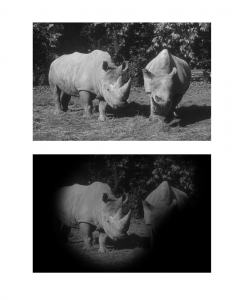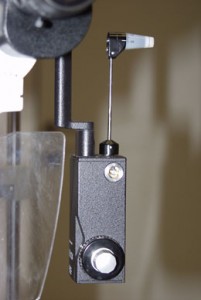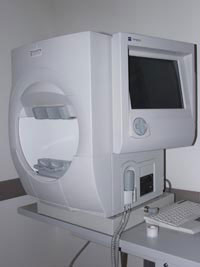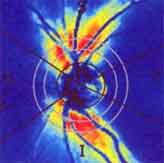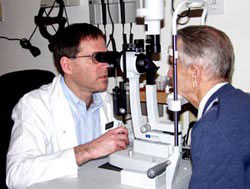Glaucoma is one of the leading causes of blindness in the developed world today. Many cases of blindness could be prevented if earlier diagnosis and treatment were initiated. Glaucoma usually causes no symptoms in the early stages, and without proper testing, significant vision loss can occur before realizing that anything is wrong. Once glaucoma is diagnosed, medications, in the form of eye drops, can help control the disease and prevent further damage to the eyes.
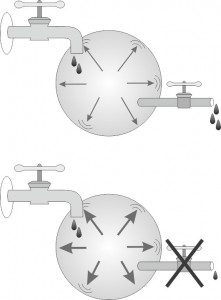
Glaucoma is a group of diseases in which damage to the optic nerve occurs as a result of increased pressure inside the eye. This increased pressure is due to a problem with drainage of fluid from the eye. The elevated pressure compresses the optic nerve, limits the blood supply to the optic nerve, consequently destroying nerve fibers and causing loss of vision.
A person with glaucoma will often lose part of his/her vision without noticing the loss. This is because glaucoma patients tend to lose their peripheral, or side, vision first. Later on, the person’s central vision will become affected too. Any vision lost because of glaucoma is gone forever.
There are several types of glaucoma, with the most common being chronic open-angle glaucoma. This type of glaucoma makes up about two thirds of all cases. It is usually painless and can be diagnosed early on during a proper eye examination. Other types include acute closed-angle glaucoma, normal-tension glaucoma, congenital glaucoma, and secondary glaucoma. We will focus on the most common type, chronic open-angle glaucoma.
People over the age of 40 are at a greater risk for developing chronic glaucoma, and most cases occur in people over 50. It is recommended to have an eye exam every two years after the age of 35, and people with a higher risk should be examined more frequently (at least once a year). These risks include a family relative with glaucoma, especially a parent, brother or sister. Other risks include diabetics, people with extreme near-sightedness, people after eye surgery or injury, and those receiving certain medications, such as steroids.
Screening tests for glaucoma can be performed by an ophthalmologist (eye-doctor). This test includes measuring your eye pressure using a device called a tonometer. If your pressure is high, or if your optic nerve appears diseased, you may be suspected of having glaucoma, and should continue with more specific tests for glaucoma.
Glaucoma is a difficult disease to diagnose because it is hard to know exactly how much pressure will damage a person’s eyes. Similarly, it is often hard to tell, upon examination, if an optic nerve is healthy or diseased. Pressure in the eye changes throughout the day, and what is considered a normal pressure for one person may do damage in another person’s eyes. Therefore you may need several visits and pressure measurements to help decide whether you have glaucoma. The doctor will also learn about your risk of having glaucoma by inspecting your optic nerve, and may use a computerized machine to analyze the nerve in detail. You may also be referred to preform a visual field test, to examine how much vision you have lost in your peripheral, or side, vision.
Glaucoma treatment includes the use of medication, as well as laser treatment and surgery when needed. Different types of drops are used to help decrease the amount of fluid produced in the eye, or to increase the amount of fluid draining from the eye. These medications are usually taken one to three times a day. Whenever you skip using the medication the pressure in your eye increases. It is very important to use the medication as instructed and to follow directions exactly, in order to prevent further damage to the optic nerve. If you are having any problems with your medications, please discuss this with your doctor so that changes can be made.
Laser treatment may be used when eye-drops can no longer control pressure build-up in the eye. The laser makes small holes in the trabecular meshwork, a part of your eye which works to filter fluid, to help fluid drain from the eye. It is a short, noninvasive procedure done at the doctor’s office. Usually laser treatment helps significantly to reduce pressure, but a patient usually continues using drops after treatment. Often the effects of the laser last up to several years, but at some point surgery may be needed.
Surgery is performed by highly qualified surgeons, although there is always a risk of complications. The procedure is performed under a local anesthetic, and takes 30-40 minutes. There is usually only minimal pain after surgery. Only one eye is done at a time. This surgery involves making a small opening to help filter fluid out of the eye, into a drainage bleb. Surgery is successful in up to 80-90% of patients, and in unsuccessful cases it can usually be repeated so that pressure is reduced in the eye. Many patients are able to stop or decrease their use of pressure-lowering medication after surgery.
Relatively rare risks of surgery include the chance of infection, decreased or blurred vision, the need for further surgery, or development of a cataract. These issues can be discussed with your surgeon before the procedure.

